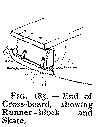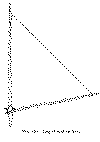By Dan Beard
How to Make the Tom Thumb Ice-Boat and Larger Craft
Although a full-rigged, delicately balanced ice-yacht looks like a very complicated piece of mechanism, when it is carefully examined the framework will be found to consist of two pieces crossing each other at right angles. The top of the cross is the bowsprit, the bottom of the cross the stern, and the sides the runners. At the intersection of the cross pieces the mast is stepped.
The principle is simple enough, and with some sticks, two small pieces of inch lumber, three old skates, and two boards, a real little "Tom Thumb Ice-Yacht" can be built to hold a crew of one, and to be rigged like a catboat or with a jib and mainsail.
The cross board may be made about 3 feet long and 6 inches wide. Make two runner blocks of inch lumber, and let them be each 6 inches long and 3 inches wide. With a bit and brace or a red-hot poker bore holes at proper distances apart for the straps of old-fashioned skates to pass through. One inch from each end of the cross board, fasten on the runner blocks securely with nails or screws (Fig. 185).
For the center plank use a board about 6 inches wide and 5 feet long. Nail the cross plank on to the center plank in such a manner that a line drawn through the center of the latter will intersect the cross board exactly at its middle. The planks must be at right angles to each other, forming a cross, the centerpiece extending about one foot beyond the cross piece; this end will be the bow of the ice-boat and the opposite end the stern.
Bore a large hole in the stern for the rudder-post to pass through. The rudder-post may be made in a variety of forms; a simple and convenient one is shown by Fig. 186.
Another hole must be made through the point where the centers of the cross and center planks intersect for the mast. Fig. 187 shows a leg-of-mutton sail, but the young yachtsman may make a sail of any description that may suit his taste.
By referring to "How to Rig and Sail Small Boats," he can find several simple kinds of sails illustrated. Fig. 188 shows the top view of an ice-boat a trifle larger than the one just described; the braces shown in the diagram are unnecessary on very small craft.
To hold the mast more securely in larger yachts, a bench is made after the plan of Fig. 189; this will prevent the mast from being carried away under any ordinary circumstances, and also prevent it from swaying with every puff of wind.
Where a seat is made as in Fig. 188, a wooden handle can be substituted for the tiller-ropes (Fig. 190).
The rudder is made of a skate; the latter is fastened by the screw at the heel and then strapped on a board nailed on to a club, shaped like a potato-masher; the small part of the club runs through a hole in the stern of the center-board.
A forked stick can be used for a tiller and must be fastened on to the rudder-post by running a pin or large wire through holes bored for the purpose in the rudder-post and the prongs of the forked stick. If the top of the rudder-post be squared, a tiller may be made of a stick with a square hole to fit over the end of the rudder-post, as shown in the illustration at the end of this chapter.
Perhaps some of my readers will invent more ingenious and simple steering apparatus than the ones given here [send your suggestions to Rick(at)Kudu.Net) ; if not, and the rudder-post and tiller seem to be a little too difficult, they may be omitted, and a stationary runner block substituted in their place. The boat must then be steered by the feet of the crew. To do this he should have on skates. If a long handle be attached to the stern like the back to a sleigh-chair, the steersman with skates on can guide the boat with his feet by standing behind and holding on to the handle at the stern. With this rig, the boat can accommodate a passenger aboard, as the steersman does not occupy the boat itself but tends the sheets and steers while being towed behind.
A common sled may be fixed with holes in it so that a cross board can be attached by movable pegs, and with a mast stepped in the bow it will make tolerable speed and may be steered by a boy on skates.






